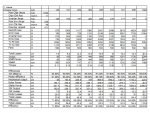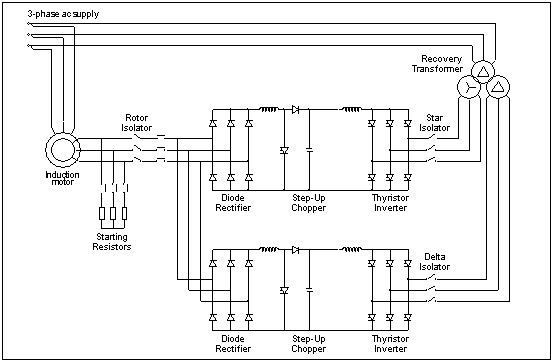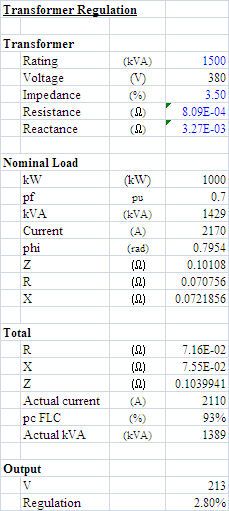So back to that: some of the Z value has resistance and that component impacts the efficiency.
Yes. The R component. Not the X. That was what I was getting at.
Here's a section of a spreadsheeet I did for a 2200 kW Kramer drive.
Losses
Chopper Amps (Adc) 125 187 262 352 456 574 707 856 1022
Max Chpr Amps (Adc) 1022
Chpr Chk Res (mohm) 11
Inverter Amps (Adc) 125 163 197 220 228 215 177 107 0
Max Invr Amps (Adc) 228
Invr Chk Res (mohm) 48
Max Rec reqired (kVA) 471
Rect/Ch loss (W) 675 1009 1417 1900 2461 3099 3819 4624 5520
DCC1 loss (W) 165 369 728 1310 2196 3484 5291 7758 11054
Inverter loss (W) 675 883 1063 1188 1230 1162 955 578 0
DCC2 loss (W) 752 1285 1862 2326 2495 2227 1503 551 0
Tx Fe loss (W) 3294 3294 3294 3294 3294 3294 3294 3294 3294
Tx Cu loss (W) 1418 2423 3511 4386 4705 4199 2834 1039 0
Fans (W) 500 500 500 500 500 500 500 500 500
Total Losses (kW) 7.5 9.8 12.4 14.9 16.9 18.0 18.2 18.3 20.4
Output (kW) 85 165 284 449 669 950 1301 1730 2244
Shaft Power (kW) 85 165 284 449 669 950 1301 1730 2244
Speed (rpm) 500 624 747 871 995 1118 1242 1365 1489
Torque (pu) 0.11 0.18 0.25 0.34 0.45 0.56 0.70 0.84 1.00
Efficiencies
ISK efficiency (%) 90.8% 93.6% 95.2% 96.3% 97.2% 97.9% 98.4% 98.8% 99.0%
Motor efficiency (%) 91.3% 93.3% 94.5% 95.3% 95.7% 96.0% 96.1% 96.2% 96.1%
Mechanical output (kW) 85.0 164.9 283.6 449.0 668.6 950.2 1301.5 1730.2 2244.0
Rotor Power (kW) 190.1 248.5 299.8 336.1 349.6 332.3 276.4 174.7 20.4
Stator Power (kW) 301.4 443.2 617.4 824.1 1063.5 1335.7 1641.2 1980.9 2356.6
ISK Output (kW) 182.6 238.7 287.4 321.2 332.7 314.3 258.2 156.3 0.0
ISK Losses (kW) 7.5 9.8 12.4 14.9 16.9 18.0 18.2 18.3 20.4
Motor Losses (kW) 26.3 29.8 34.0 39.1 45.4 53.3 63.3 76.0 92.2
Total Losses (kW) 33.8 39.6 46.4 54.0 62.2 71.3 81.5 94.4 112.6
Efficiency (%) 71.6% 80.6% 86.0% 89.3% 91.5% 93.0% 94.1% 94.8%
95.2%
They don't paste altogether correctly on forums but all the numbers are there. And it's a real application in operation in a cement works.




